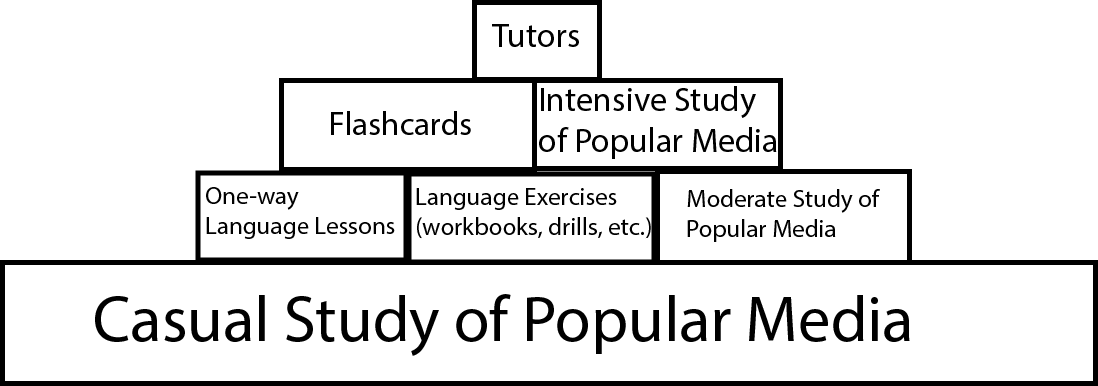
Don’t do this: it’s unnecessary, unpleasant, and not even the best way
Shortly after beginning to learn a language for the first time (few weeks, couple of months, something like that), you’ll figure out which of the activites you’ve been doing yields the best result in the least amount of time when you’re fresh and focused. You will then attempt to force yourself to do this one activity all the time (because $100/hour for 10 hours straight is better than $100/hour for 2 hours and then $20/hour for the next 8 hours, right?).
This will not work because you will, in short, burn out after doing this activity for [amount of time less than you were hoping] because it is inevitably mentally intensive. Interspersing your performance of this particular language-learning activity with breaks, e.g. 5 minutes every 25 minutes, is better than nothing but it’s still not even close to the best way that I’ve found.
A balanced language-learning diet
You’ll want to do a wide variety of activities, a sort of balanced diet of language-learning where certain exercises are essential but should only be taken in small to medium amounts whereas others can and generally should be taken in larger amounts at more frequent intervals. They vary not only in difficulty but also in which of the four main language skills they focus on: speaking, listening, reading, or writing. The order in which these four skills should be prioritised by the student depends on the student and their objectives, that is what’s important to them. If you’re learning the language primarily in order to be able to communicate with native speakers face-to-face (that’s most of you), your needs and therefore the skills you should focus on practicing will be different from someone who needs to learn the language to pass an exam or understand academic papers in their field (you’ll find a disproportionate amount of these people in the hard sciences learning French, incidentally, and if this is you I strongly recommend French for Reading by Sandberg and Tatham).
Andrew’s Language-Learning Pyramid
I feel silly doing this but it helps illustrate the point. Note this is just a rough idea of one possible combination that I think would work well for a lot of people (it may not be the best way for you to learn a language but it’s probably a pretty good one). I expand on these below.

- Tutors: As I’ve said before, one-on-one sessions with a good tutor give you the best bang for your buck, that is to say that they have the best possible ROI of anything you could do. You’ll learn more per minute in a good tutoring session than you will (per minute) doing anything else. Nothing beats a good tutor. It’s at the top because of this, however it’s also the smallest block in the pyramid because for reasons of money and time, most people can only spend a fraction of their total available language-learning time working with a tutor, e.g. perhaps 2 out of the 10 hours every week they’re able to make available for learning a language. Tutors require you to be in a quiet environment with a computer/smartphone, have a good internet connection, and you have to be able to give them your uninterrupted attention for 30-60 minutes straight. You can’t do this on your commute, while walking/jogging, in a cafe (some, maybe, most are too noisy), or when you only have 10 or 15 minutes available.
- Intensive Study of Popular Media: This is what I like to emphasize, it’s where you pick a movie, series, or song in the language you want to learn, turn on subtitles in the language spoken (or have the lyrics in front of you in the case of a song), and then look up everything you don’t understand, speak it aloud until you sound like the native speaker, and possibly note down some/all/none of what you learned (this depends on several factors I won’t get into here).
- Flashcards: This is where you review that which you have deigned to note down, those things that were noteworthy (not all is, in fact most isn’t). This is going to be just about everything you learned in your tutoring session along with some/all of what you learned from previous study sessions with popular media, some of what you learned from one-way language lessons (like on YouTube) which I’ll discuss next, etc. This is important, so it’s high up, but it also gets boring quickly so I don’t want you to spend too much time on it (maybe 15-90 minutes a day for most of you, depending).
- One-Way Lessons: This is what I decided to call lessons about a language intended for students of it that are in the form of a video, blog post, PDF, podcast, book, etc. I call them “one-way” in order to distinguish them from tutoring sessions which are two-way (you talk to the tutor, they talk to you). I currently get almost all of mine from YouTube. Some examples include channels like Butterfly Spanish, Spanishland School, Comme une Française, Français Authentique, and Easy German. All of these are channels I can enthusiastically recommend, by the way. For lot’s more YouTube channels to check out as well as advice on using YouTube to learn languages, please see the section of my blog, Learn Spanish from YouTube.
- Moderate Study of Popular Media: Same as intensive study except you’re not looking up everything you don’t know, just whatever you, in your best judgement, deem important. You note even less of it: only that which you think it highly likely that you’ll forget if you don’t note it down and review it.
- Casual Study of Popular Media: This block is the biggest because you can spend a ton of time doing it because it’s not mentally intensive, you can afford to be occasionally distracted, and you’re not noting much if anything down at all (you can if you want here and there, it’s very “meh, do what you feel like”). It’s on the bottom because it yields the least amount of learning per unit of time. The input, however, still must be comprehensible: this means that if your listening comprehension isn’t good enough yet to understand most of it without subtitles (in the language spoken), then you need subtitles on, and it also means you should look up what you can’t understand (don’t worry, you’ll get most of it through context, plus looking something up takes two seconds when you’ve got Netflix/YouTube open in one tab and a Spanish dictionary in the other, for example). Not only will you learn new words, grammar, and syntax this way but also, and also very importantly, you’ll review that which you already know and you’ll review it in a new way and a new context (this is fantastic for reinforcing something into your long term memory, far better than seeing the same word/phrase over and over again in the same way and the same context, e.g. the same flashcard). Just because it’s on the bottom doesn’t mean it’s any less important than stuff which is higher up.
Ok, I have to stop here, and I suspect you want me to. I’ll recommend a couple resources for you to check out, then we’re done:
Tutors: I recommend iTalki. No one else is as large or as good right now in my opinion. You can get excellent one-on-one tutoring sessions for about $7-15 (U.S. dollars) per hour. Check out my review of them here for more information. You can also find free language exchange partners on here.
Group classes: As you know and I’ve mentioned elsewhere, conversing with native speakers is crucial and has to be done sooner or later. A great way to do this is via online classes where the native speaker is the teacher. I personally can recommend a service called GoSpanish (this is my review of them), having tried it myself. You can get unlimited classes with them (online, via a video call using a Skype-like system) for as little as $39 per month – that’s insane. You could take multiple one-hour long classes every day and just pay $39 a month for it if you wanted. They also guarantee you won’t have more than about five students per class, and in my experience it was less than that (sometimes it was just me and the teacher).
A great tool to help you learn from popular media: Yabla (this is my review of them) is a service that takes popular media like TV shows and short video clips in the language you’re learning (they offer several) and embeds the video in a special platform specifically designed to help students learning that language do so from that video. You get subtitles in both the language spoke and your native language, you can click on any word in the subtitles to see a definition of it and have it automatically added to your flashcards they provide for you to review later what you learned, you can have quizes and games based on the language used in the video, etc. It’s really good, check out their site here or, again, you can see my review of them here.
Lastly, I wrote a book about how to learn Spanish from popular media (movies, TV shows, music, etc.) that you can get on Amazon in Kindle or paperback format. If that interests you and especially if you’d like to support my work, I’d really appreciate if you could check it out here on Amazon, it’s called The Telenovela Method.
I hoped that helped, leave a comment if it did/didn’t or you have any questions or suggestions.
Cheers,
Andrew






